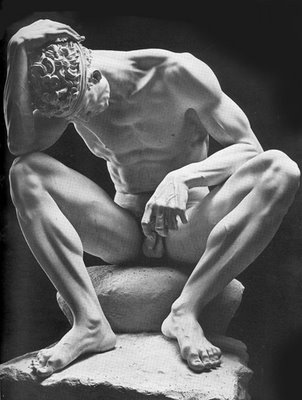Göz Lokumu

A controversial art exhibit in the town of Schwerin has many Germans up in arms. The exhibit features the work of Arno Breker (1900 – 1991), a prominent 20th-century German sculptor whose neo-classical works featuring muscular youths in heroic poses were prized by Hitler and other Nazi leaders.
Many consider Breker to have been a Nazi propagandist. They point to the fact that he produced busts of high-ranking Nazi leaders (including Hitler) and accepted commissions to produce monumental works as part of Nazi-funded public art projects, such as the sculptures of athletes that decorated the Berlin stadium built for the 1936 Olympic games.
Although Breker accepted Nazi patronage, he never joined the Nazi party. After the war, moreover, he continued to be respected and commissioned by world leaders. His post-war busts included West German Chancellor Konrad Adenauer, who restored relations with France, and Egyptian President Anwar al-Sadat. An Arno Breker Museum opened in 1985.
Still, many Germans feel that his works should not be on display as part of a publicly-funded exhibit. I myself (not being German) cannot help but admire the beauty of his sculpted forms. Were I to have stumbled across one of his heroic youths without knowing anything about the artist, I surely would have admired the figure’s beauty and perhaps been aroused by the homoeroticism lingering under the surface. Breker’s talent as an artist was widely recognized, and his ability to bring stone and metal to life once got him labeled “Germany’s Michelangelo.”
Looking at his works online, I find that my reaction is much the same, even though I now know about his more questionable commissions. It would be dishonest of me to say that his work repulses me now that I know about how some of it originated.
Pictured above is Breker’s Wounded Warrior (1940).












9 Comments:
Being a germanist myself I couldn't agree more with you. As usual, the Germans overreact and easily fall to both extremes...
I find that sculture most beautiful. It's homoerotic too, I find.
Mmmmm. Simply beautiful to behold. I will have to look into his work.
Several years ago, I made love to a windshield while working as a commercial truck driver and sustained a serious closed head injury that messed up my optical nerves.
Eventually I found myself under the care of surgeon at the U of W who was from India. For some reason one day we found ourselves discussing art, symbolism, and how certain works of art have been ruined or stigmatized because of political agendas or historical events.
We both agreed that the context often pollutes works of art, the artist, or the society that produced these works. Historical baggage leaves the viewer suspended, unable to resist the temptation to judge these expressions on merit totally unrelated to the piece of art before them. Most art is made within a certain context, but this creativity shouldn't have to be cemented to the political forces in control at the time of their creation.
In India the symbol most identified with the Nazi's is a long standing ancient religious symbol. Yet because of the Nazi's corruption of this symbol, something once sacred now bears the unintended baggage that stems from a culture completely unrelated to its origins.
Anyway, interesting musings...and thanks for posting such a beautiful image...
Timbo
At least the exhibit seems to show ths artist in his true form, which is extrememly paradoxal. However, I cannot criticize the German or Jewish population for wanting the exhibit halted - or can I believe that they are overreacting. What is the expression, "Until you walk in my shoes....."
As Dean can attest, we had an uncle that had very little use for anything German, and with good reason.
That doesn't mean that we take on his feelings, but we must respect the origins of them and put them into perspective.
Good insight Dean...........
ric-
check out the article on glbtq by clicking on the "homoeroticism" link in my post. it's really well written.
christopher-
you should check out his other works too :)
timbo-
well said. i like your point about context polluting art. sometimes, we are drawn to the artist's creativity and repulsed by the context. some art leaves us feeling torn. your example of the indian symbol being coopted by the nazis as the swastika demonstrates how easy it is for symbols to be corrupted. thanks for your comment. keep commenting!
g-
thanks for your comment. your point is well taken.
i think we have to recognize that different people are going to react differently to the same work of art. those who admire a controversial work must understand the feelings of those repulsed by it, but the reverse is also true.
those repulsed by a work do not often recognize that others can find value in it. just because something offends me doesn't mean it will offend everyone. i cannot expect my feelings to dictate policy, right?
the result of this failure to recognize the diversity of opinion that exists is a push for censorship. i would argue that those who are offended don't need to look. but those who are offended must not be allowed to deprive others of their right to look.
That sculpture is startling in its beauty... the pose of the wounded warrior takes ones emotional breath away. Makes one want to reach out, touch, embrace and console him, him who is yet robust and strong and dynamic. I'll have to check out his other works.
treeboy-
yes, yes! he begs for touch.
check out this post for a similar discussion of how those who are offended by a particular exhibit (a scientific one in this case) should not expect their sensibilities to dictate policy.
my point exactly - putting into perspective in my mind means that we have to exercise tolerance for another person's viewpoint. It is only natural that we expect the same in return.
To dismiss another person's viewpoint, especially a passionate one makes me no better than the censor.
One has to live by example ----
Post a Comment
<< Home